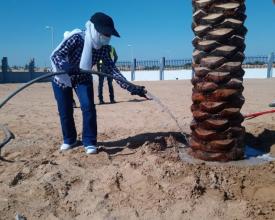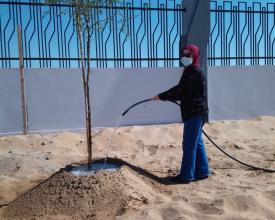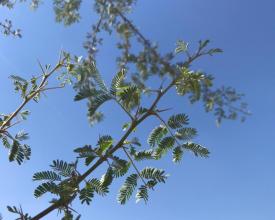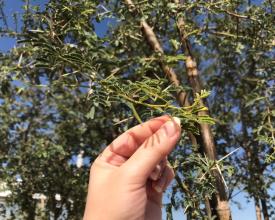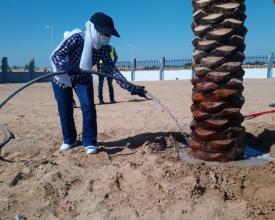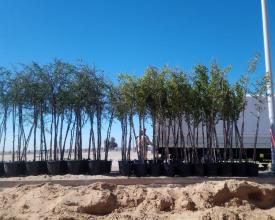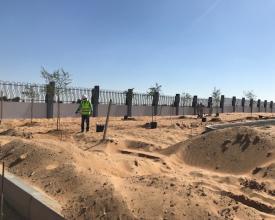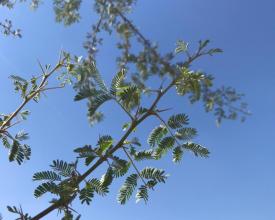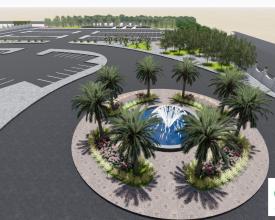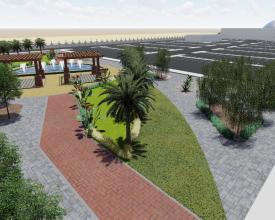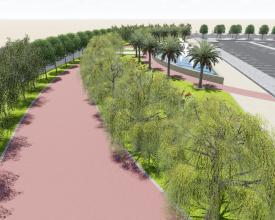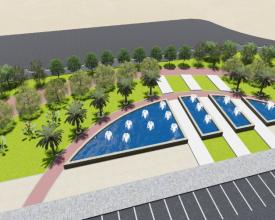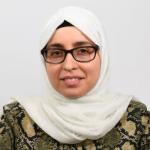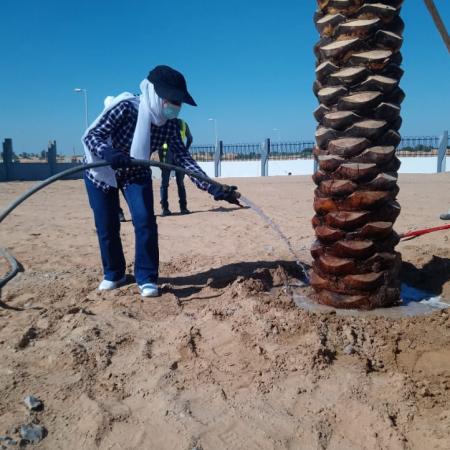
Old is Gold: Healing from within by the Indigenous Plants
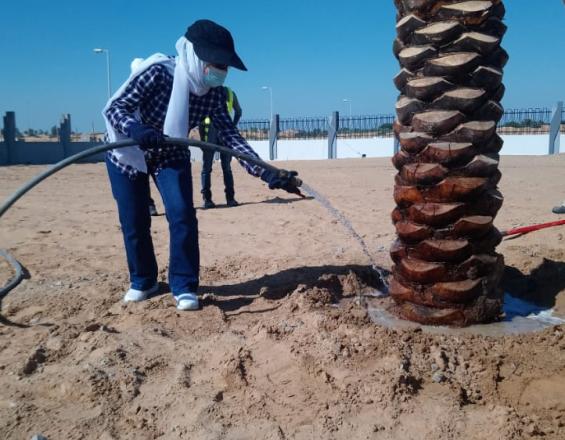
The United Arab Emirates (UAE) is located in a desert region. This initiative exclusively uses the UAE’s indigenous plants to create the "First National Landscape" at the new campus of Umm Al Quwain University (UAQU). The initiative includes two elements: softscapes and hardscapes. The softscapes include native species of trees, shrubs and groundcovers. While the hardscapes consist of coloured gravels, gazebo structures, barbeque facilities, water fountains, jogging tracks and sports areas. Multi-factors were considered to minimize the landscaping requirements (e.g., water irrigation, maintenance and costs), while creating multi-functional areas that add value to the project (e.g., sports, barbeque, meditation and recreational areas), conserve native biodiversity, generate cultural and sustainability benefits, and foster climate-resilience. This initiative is expected to inspire decision-makers and other landscaping projects in arid lands to take similar approaches.
Context
Challenges addressed
The use of exotic plants and neglect of indigenous plats in landscaping projects has become increasingly problematic. This initiative seeks to encourage the use of indigenous plants in landscaping projects by promoting the benefits which include: addressing climate change sustainably, promoting native biodiversity, generating cultural benefits, and minimising cultivation costs (e.g. associated with irrigation, fertilisation and maintenance).
Location
Process
Summary of the process
Softscapes (by native plants) and hardscapes together create an integrated, interesting and functional landscape comprising a range of elements, features and purposes. The use of hardscapes minimizes the consumption of natural resources (e.g., water and fertilisers) and cultivation associated costs, while creating sustainable, interesting & functional landscaping components. This is particularly needed to cope with climate change impacts in arid lands
Building Blocks
Softscapes: Indigenous Plants
The softscapes include indigenous species of trees, shrubs, & groundcovers. Around 19 indigenous plant species are used in the project. Multi-factors were considered to minimize the landscaping requirements (e.g., irrigation, maintenance and costs) while conserving native biodiversity, generating cultural and sustainability benefits, and strengthening climate resilience. This initiative is intended to inspire decision-makers and other landscaping projects in arid lands to take a similar approach.
Enabling factors
- References related to native plants, and updates on their status.
- Native plants suppliers and germplasm conservation of the native species.
- Expertise related to native plants, their sustainable use and propagation.
- Cultural awareness on the importance of utilizing native plants and enhanced public appreciation of their desert features, shapes and colours.
Lesson learned
- Value of native plants and the necessity to raise social awareness on their benefits
- The need to employ scientific knowledge for the implementation of real projects
- There is an opportunity to achieve long-lasting beauty of the landscape by cultivating native plants while minimizing costs and resource inputs (e.g., irrigation, maintenance and fertilization)
- Native plants offer authenticity and traditional cultural values
- By planting indigenous species of plants, one can foster rich native biodiversity. This can be done by germplasm conservation, propagation & natural restoration. This can significanlty reduce the severity of the desertification & extensive urbanazation activities.
Hardscapes: Constructed Landscaping Elements
The hardscapes consist of coloured gravels, gazebo structures, barbeque facilities, water fountains, jogging tracks and sports areas. Multi-factors were considered to minimize the landscaping requirements (e.g., irrigation and maintenance) and costs, while creating multi-functional areas that add value to the site (e.g., sports, barbeque, meditation, recreational areas, sitting & walking areas).
Enabling factors
The design should maintain a balance between softscapes and hardscapes in order to achieve the desired level of greenery while minimising costs. Also, the design should make good use of the landscape to enhance the functionality of the landscaping area.
Lesson learned
There is a real need to use hardscapes in landscapes located in arid regions to reduce dependency on cultivated softscapes & their related requirements (watering, maintenance & costs), while creating interesting features & functional areas in the landscape. One of the key lessons learned is, while planning for a landscape in the desert region, try to best construct & implement hardscaping components (e.g., mulch, colored stones, gazebo, barbeque areas, recycled water fountain) to enrich the diversity & functionality of the established sustainable landscape, while reducing the irrigation water needs, maintainance & total costs. What mostly make sense to the landscapes' visitors is the the general overview of landscape & how it's interesting to the eye, while creating functional areas, & not necessaarly the big number of cultivated plants is the only significant factor to establish a landscape. Thus, best use both hardscapes & softscapes together & alternatly to create a sustainable interesting landscape in arid lands
Impacts
Climate change poses many challenges to landscaping in arid lands. Native plants are the best options to cope with climatic changes. However, people tend to use exotic plants for landscaping, neglecting the use of native ones. The New University Campus total area is 650,806 m2, & the initiative's total area is around 50,000 m2. The New Campus capacity is 5000 students, 600 faculty, staff & admistrators. The initiative includes 20 native perennial species; 5 species as ground covers/grasses "Paspalum vaginatum, Sesuvium portulacastrum , Sesuvium verrucosum, Pennisetum setaceum, Cymbopogon commutatus", 8 shrubs "Ochradenus aucheri, Aerva javanica, Haloxylon salicornicum, Aloe vera, Calotropis procera, Senna alexandrina, Tephrosia apollinea, Pulicaria glutinosa", & 7 trees "Phoenix dactylifera, Prosopis cineraria, Acacia tortilis, Vitex agnus-castus, Vachellia nilotica, Ziziphus spina-christi, Salvadora persica". Most of the plants are well-known in traditional medicinal practices, & are drought/ salt tolerants. Ochradenus aucheri & Senna alexandrina considered by Inter. Center for Biosaline Agriculture as threatened. The initiative promotes the use of native plants to cope with climate change. Conserving natural resources & heritage sustainabily
Beneficiaries
The main beneficiaries including:
- Umm Al Quwain University community (faculty/staff/students) and public visitors
- Proponents of landscaping projects who stand to be inspired
Story

When this idea was first proposed, there was various uncertainties about the feasibility & value of the native plants' option. I discovered that most people think that a country located in the desert region has few number of weak & faded color native plants, and nothing can compete the beauty of the common used exotic plants. To most people, the idea of cultivating a landscape with the exclusive use of native plants was not any of the possible options. Many comments were emphasizing on the need to have a cultivated nice-looking landscape & not an empty desert land. However, this feeling later completely changed into fully gratitude to the mother nature when the cultivation process started & the live museum surrounding the campus start apearing, & we are now aiming to inspire & lead a new trend of landscaping in arid lands, strongly based on raising awareness of people on the jeweleries of the desert lands & sharing their own authentic natural beauty with their community & the world

